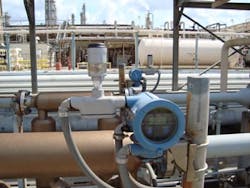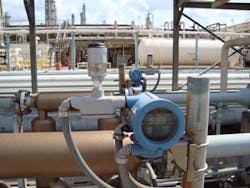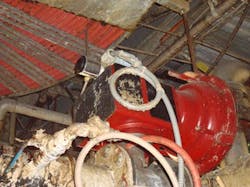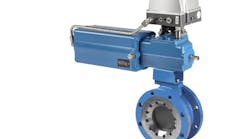Despite the heightened coverage of industrial wireless in recent years, wireless is not really a new technology for industry. Radar and satellite systems, for example, have been employed for decades to transmit machinery health information from offshore oil and gas rigs back to onshore control rooms. Early iterations of industrial wireless, however, were proprietary in nature, and recent efforts to standardize the wireless platform for industrial applications have been the driving force behind the amped up discussion over the past few years. At the same time, the preponderance of consumer wireless technologies currently making their way to market has fostered a comfort level with wireless in general that is provoking some experimentation on the industrial side.
Standardization Provides More Options
There are two standardization movements afoot that warrant consideration from an end-user’s perspective – ISA100 and WirelessHART. ISA100 (isa.org/isa100) is an umbrella initiative that is currently working on developing a suite of wireless standards to meet a range of application requirements. WirelessHART is an internationally approved (IEC 62591) wireless standard, currently available as part of the HART 7 communication protocol offered by the HART Communication Foundation.
The standardization movement has enabled device manufacturers to cost-effectively develop wireless technologies that are interoperable with a variety of supervisory control systems. This, in turn, has allowed end-users to pick-and-choose from a pretty broad base of proven technologies with a certain level of comfort that the device will seamlessly integrate with their existing systems. “No longer do engineers have to chose sub-optimal measurement technologies if they want to be wireless, they can get their favorite wired device in a wireless option,” says Lara Kauchak, director of wireless sales and marketing for, Emerson Process Management.
For fluid handling applications specifically, Kauchak says Emerson has employed the WirelessHART specification to develop battery-powered wireless differential-pressure flowmeters and WirelessHART adapters, which can be added to wired vortex flowmeters, magnetic flowmeters, and Coriolis flowmeters to wirelessly transmit flow variables and advanced diagnostics back to a control system. If the facility uses an older control system that does not have native capabilities for HART diagnostics, she says WirelessHART adapters can be used with wired flowmeters to send the diagnostics to an asset management system, while the 4-20mA flow variable continues to be transmitted to the control system via the original wiring.
The existence of two wireless standards initiatives for industry (i.e., ISA100 and WirelessHART) has been a source of contention for some end-users, device manufacturers, and those involved with the respective standards themselves. And while there has been some discussion of developing a certain level of interoperability between the two standards, this effort has thus far been slow to develop.
Ultimately, whether its ISA100 or WirelessHART or a mix of both, the move toward a standards-based platform for wireless systems is advantageous for a number of reasons. “It provides the industry with open standards for device manufacturers to cost-effectively develop products,” says Sandro Esposito, global marketing manager for SMART Products at GE Energy. “This eliminates some of the FUD (fear uncertainty and doubt) from the users knowing that there’s more than one available wireless device for a given application and that devices from various vendors can work seamlessly together within a harmonized backbone. The result is therefore obvious – more pull by the end-users, and less push by the vendors.”
“The future of the standards will be decided in the market by customers,” says Emerson’s Kauchak. “However, the benefits of wireless are so big for end-users that no one is waiting for convergence. The standards have allowed over 17 major instrumentation vendors to introduce wireless products. Without this, users would be forced into proprietary protocols without interoperability.”
Wireless Monitoring vs. Control
Generally speaking, wireless systems for fluid handling applications have, to date, been primarily used for monitoring rather than control. And while both WirelessHART and ISA100 profess to be capable of supporting control-based applications, there is some reluctance among the end-user community to extend wireless strategies beyond general monitoring-type scenarios.
“From a pure measurement and monitoring standpoint of a fluid, several applications can be implemented using wireless, and many customers have been for many years,” says GE Energy’s Esposito. “Now, doing PID control using signals coming from a wireless transmitter and sending a command signal wirelessly to a control valve positioner is a completely different matter, and I think that the technology isn’t there yet for end-users to implement a robust, reliable and sustainable installation.”
While the ISA100.11A, the first standard under the ISA100 umbrella, and WirelessHART protocols have strong security built in, Esposito says end users’ primary concern regarding wireless control is cyber-security and the fear that hackers could “take over” the control. Also, he says there’s a speed issue to consider, as certain control loops need to process a measurement, compare with a setpoint, and then send a command to a control valve, for example, in less than one second. In such implementations, battery-powered devices would last less than one year. As such, he says end-users should be selective when targeting applications for wireless until the technology evolves to provide such things as added redundancy and integrated wireless control within the field device.
On the other hand, Esposito says there are obvious natural applications for wireless where end-users can realistically expect to employ wireless to improve the process. “The biggest bang for the buck in utilizing wireless for fluid handling can be applied to applications that are remote or isolated from the distributed control system’s network and to monitor the health of control valves connected to older process controllers,” says Esposito. “For such applications, the end-user can make measurements, such as level, pressure, flow, temperature, pH, etc., and relay that information to the supervisory system in a cost-effective manner.” For instance, he says wireless transmitters on remote pipelines can feedback the flow and pressure to a nearby monitoring station without running any wires. The monitoring station can then feedback this information using satellite communication, radio signals, etc. This eliminates the cost of direct wiring or, alternatively, the time and effort that would have been required to send an operator out to the pipeline to manually record process performance data on the pipeline. For control valve monitoring, the wireless technology bridges the gap of legacy control systems incapable of reading the information contained in common digital valve positioners.
While Esposito sees “full” wireless control as a little further off for valve applications, Emerson’s Kauchak sees control applications in more of a near-term perspective.
“With any new technology, you don’t want to try it out on your most critical applications and control,” she says. “However, WirelessHART was written to support control from the very beginning. As end-user engineers get more experience with what the technology can deliver, it’s migrating very naturally to control applications.”
Kauchak says WirelessHART incorporates the capability for faster update rates, redundancy in the systems, and enhanced security to enable certain wireless control-based scenarios. For flow applications, for example, wireless is good for continuous flow where flowrates don’t change dramatically over time – like steam line and cooling water. She says wireless is also a good fit for critical applications where a secondary measurement is critical for a redundancy scheme. In such a scenario, she says, “If the wire from a flowmeter is disturbed or an analog value is distorted, WirelessHart can be read back into system for a secondary level of backup.”
Application Considerations & Common Pitfalls
When developing a wireless application, one of the key considerations end-users need to be mindful of is power. The more updates the application requires, the more power required. For wireless systems, this is an issue because most wireless transmitters are powered by battery. The power available is in limited supply, which means end-users should always carefully consider how many updates are required and try to minimize those updates.
“How the wireless device will be powered is something that is often not looked at carefully, especially for those applications involving an adaptor,” says Esposito. “Most of these adaptors will scavenge power from the incoming 4-20 mA signal and therefore will result in a voltage drop. If the added voltage from the wireless adaptor and the field device exceeds the capability from the power source, then the installation will simply not work.”
Esposito says this sort of scenario is typical with analog output cards where a valve positioner is installed on an older control system. Such analog output channels have limited voltage availability to start with. So, he says with the added wireless adaptor, the analog output is simply incapable of powering both devices.
Another key consideration for wireless systems is cyber-security. While both ISA100.11A and WirelessHART are designed with robust cyber-security protection, Esposito says end-users are still worried about the possibility of hacking. He believes these concerns will be alleviated as end-users gain a greater understanding of the security features included in ISA100.11A and WirelessHART.
When devising a wireless strategy, Kauchack says end-users should look for unexpected places where wireless can deliver big benefits. She says utilities and energy management are big opportunities for users to save money. “Often, just eliminating the wiring cost isn’t the biggest value, although it may be the first one that you think of,” she says. “For flow measurement, being able to very quickly install a DP flowmeter in a fraction of the time and engineering of a traditional wired flowmeter with piping changes allows for new measurements to be added where they were never feasible before.”
The Future of Wireless
Going forward, Kauchak says to look for industrial wireless to evolve similar to the way wireless systems have on the consumer side. “Only 10 years ago cellphones were bigger, with tiny black and white displays, and batteries that lasted only a few hours,” she says. “You couldn’t surf the web or do much but make calls with them. Industrial wireless will also continue to evolve – new measurement types specifically designed for applications, which no one has ever put on a PID because there simply wasn’t a way to measure them, will be developed; update rates will decrease and control will be mainstream – just as monitoring with wireless is nearing mainstream adoption today.”
Esposito is also optimistic about the future of wireless for industry, as he predicts manufacturers will likely resolve most of the constraints related to powering wireless devices without the need for batteries. “This will allow end-users to further adopt and implement wireless,” he says. “In addition, most control systems will offer a means to seamlessly integrate variables coming from wireless field devices, which will then provide for more advanced applications using wireless.”
Further out, Esposito predicts wireless systems will allow field devices to go beyond transmitting, receiving, and passing variables to a wireless gateway. He predicts the technology will become a communication bus, similar to FOUNDATION Fieldbus, where field devices can exchange variables with each other in a deterministic way, such that process control will be handled in the field wirelessly.
Matt Migliore is the editor in chief of Flow Control magazine. He can be reached at [email protected].




